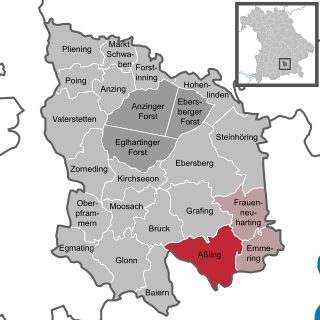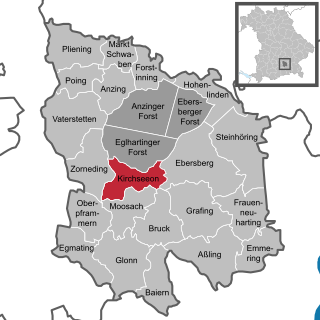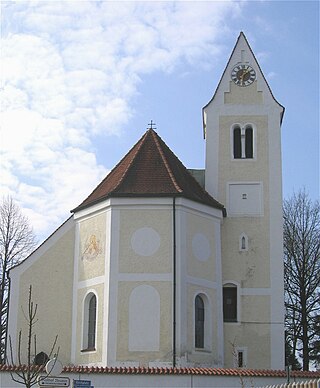
Landkreis (district) Ebersberg is located in Upper Bavaria, Germany. It is bounded by the districts of Erding, Mühldorf, Rosenheim and Munich.

Unterschleißheim is a town in Bavaria, Germany. It is located about 17 km north of Munich central, and has a resident population of 29,464.

Ebersberg is the seat of the similarly named Ebersberg Landkreis (district) in the Oberbayern Regierungsbezirk in Bavaria, southern Germany. The Ebersberger Forst (forest) is one of Germany’s largest continuous area of woodlands.

Puchheim is suburb to Munich in the district of Fürstenfeldbruck, in Bavaria, Germany. It has about 20,000 inhabitants.

Zorneding is a community in district of Ebersberg, Upper Bavaria, Germany. It lies some 20 km east of Munich, Bavaria’s capital.

Hohenlinden is a community in the Upper Bavarian district of Ebersberg. The city of Lynden, Washington is named after it, as is Linden, Alabama. Hohenlinden is also the subject of an eponymous poem by Thomas Campbell.

Eching is a municipality in the district of Freising, in Upper Bavaria, Germany.

Grafing bei München is a town in the district of Ebersberg, Upper Bavaria, Germany.

Oberschleißheim is a municipality in the district of Munich, and a suburb to Munich in Bavaria, in southern Germany. It is located 13 km north of Munich (centre). As of 2005 it had a population of 11,467.

Markt Schwaben is a town in Bavaria, Germany. It lies roughly 23 km east of Munich on the northern edge of the Upper Bavarian district of Ebersberg. Neighbouring communities are Anzing, Forstinning, Pliening and Poing, as well as Finsing, Ottenhofen and Pastetten.

Poing is a municipality in the Upper Bavarian district of Ebersberg, lying 18 kilometres (11 mi) east of central Munich.

Anzing is a municipality in the Upper Bavarian district of Ebersberg.

Aßling is a municipality in the district of Ebersberg, Upper Bavaria, Germany. It is, along with the communities of Emmering and Frauenneuharting, a member of the administrative community of the same name.

Bruck is a community in the Upper Bavarian district of Ebersberg. It is a member of the municipal association (Verwaltungsgemeinschaft) of Glonn.

Emmering is a community in the Upper Bavarian district of Ebersberg. It is a member of the administrative community (Verwaltungsgemeinschaft) of Aßling.

Forstinning is a community in the district of Ebersberg in Upper Bavaria, Germany.

Kirchseeon is a market town in the Upper Bavarian district of Ebersberg and lies 15 km east of Munich city limits.

Moosach is a municipality in the Upper Bavarian district of Ebersberg and a member of the Verwaltungsgemeinschaft of Glonn.

Baldham is a district of Vaterstetten in the Upper Bavarian district of Ebersberg, Germany. It is located approximately 18 km east of the state capital Munich and 15 km west of the district capital Ebersberg.

The Munich–Rosenheim railway is a 65 kilometre-long double-track main line of the German railways. It connects Munich Hauptbahnhof with Rosenheim station, where it connects with the Rosenheim–Salzburg railway, which connects with the line to Vienna at Salzburg, and the line to Kufstein, which continues to Innsbruck and the Brenner line to Italy. The line is part of the "Main line for Europe", connecting Paris with Bratislava and Budapest and the almost identical line 17 of Trans-European Transport Networks (TEN-T). It is part of the line 1 of TEN-T. It is electrified at 15 kV, 16.7 Hz. It was opened between Munich and Rosenheim in 1871.


























